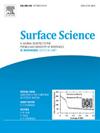量子工程:异质金属cr - gannss (M = Mn, Fe, CO, Cu和Zn)共掺杂对CO气体的吸附行为和敏感性:D-PBE/DNP方法
IF 2.1
4区 化学
Q3 CHEMISTRY, PHYSICAL
引用次数: 0
摘要
通过纳米结构共掺杂的量子工程已经成为带隙调制和增强光学、电学、磁学和光催化性能的有力策略。这项工作旨在探索不同过渡金属的加入如何影响GaNNSs在grime色散校正PBE/DNP理论水平上的电子性能和CO气体传感能力。设计了两种异质共掺杂的CrM(1,3)Ga和CrM(1,5)Ga (M = Mn, Fe, Co, Cu和Zn)结构。计算了结构参数、吸附能、结合能、电荷转移值、带隙能、气体解吸恢复时间、化学硬度、功函数、电子密度性质和态密度图。Cr*M和CrM*吸附配合物的ae分别在-25.0 ~ -30.0和-4.0 ~ -21.0 kcal/mol之间变化。观察到的CrMn、CrFe和CrCo共掺杂gan - ns磁性能的变化表明它们具有自旋电子应用的潜力。与原始GaNNS相比,所有异种共掺杂GaNNS的H-L能隙都显著降低。这表明共掺杂促进了新的电子态的形成,从而增强了电子离域及其在传感器等应用中的性能。吸附CO气体后,CrCu(1,5)Ga、CrZn(1,3)Ga和CrZn(1,5)Ga gan - ns的平均带隙变化幅度分别为0.27 eV、0.22 eV和0.33 eV,恢复时间分别为19 s、8.2 s和3.1 s,有望成为室温下可重复使用CO气体检测传感器的候选材料。该研究有望为异质共掺杂gan - ns的CO气敏应用提供有价值的见解。本文章由计算机程序翻译,如有差异,请以英文原文为准。

Quantum engineering the adsorption behavior and sensitivity of GaNNs toward CO gas by hetero metal CrM-GaNNSs (M = Mn, Fe, Co, Cu and Zn) co-doping: a D-PBE/DNP approach
Quantum engineering through nanostructure co-doping has emerged as a powerful strategy for bandgap modulation and the enhancement of optical, electrical, magnetic, and photocatalytic properties. This work aims to explore how the incorporation of different transition metals affects the electronic properties and CO gas sensing capabilities of GaNNSs at Grimme's dispersion-corrected PBE/DNP level of theory. Two hetero co-doped CrM(1,3)Ga and CrM(1,5)Ga (M = Mn, Fe, Co, Cu and Zn) configurations were designed. The structural parameters, adsorption energies (AEs), binding energies, charge transfer values, band gap energies, recovery times for gas desorption, chemical hardness, work function, electron density properties and density of states plots were calculated. The computed AEs changed from -25.0 to -30.0 and -4.0 to -21.0 kcal/mol for Cr*M and CrM* adsorption complexes, respectively. The observed changes in magnetic properties of CrMn, CrFe and CrCo co-doped GaNNSs suggest their potential for spintronic applications. A significant decrease in the H-L energy gap was observed in all hetero co-doped GaNNSs compared to pristine GaNNS. This reveals that co-doping facilitates the formation of new electronic states, which enhances electron delocalization and their performance in applications such as sensors. Upon adsorption of CO gas, the CrCu(1,5)Ga, CrZn(1,3)Ga and CrZn(1,5)Ga GaNNSs demonstrate significant modification in average band gap change by 0.27 eV, 0.22 eV and 0.33 eV, and recovery times of 19 s, 8.2 s and 3.1 s, respectively, making them promising candidates for reusable sensors for detection of CO gas at room temperature. This study is anticipated to offer valuable insights into the CO gas sensing applications of hetero co-doped GaNNSs.
求助全文
通过发布文献求助,成功后即可免费获取论文全文。
去求助
来源期刊

Surface Science
化学-物理:凝聚态物理
CiteScore
3.30
自引率
5.30%
发文量
137
审稿时长
25 days
期刊介绍:
Surface Science is devoted to elucidating the fundamental aspects of chemistry and physics occurring at a wide range of surfaces and interfaces and to disseminating this knowledge fast. The journal welcomes a broad spectrum of topics, including but not limited to:
• model systems (e.g. in Ultra High Vacuum) under well-controlled reactive conditions
• nanoscale science and engineering, including manipulation of matter at the atomic/molecular scale and assembly phenomena
• reactivity of surfaces as related to various applied areas including heterogeneous catalysis, chemistry at electrified interfaces, and semiconductors functionalization
• phenomena at interfaces relevant to energy storage and conversion, and fuels production and utilization
• surface reactivity for environmental protection and pollution remediation
• interactions at surfaces of soft matter, including polymers and biomaterials.
Both experimental and theoretical work, including modeling, is within the scope of the journal. Work published in Surface Science reaches a wide readership, from chemistry and physics to biology and materials science and engineering, providing an excellent forum for cross-fertilization of ideas and broad dissemination of scientific discoveries.
 求助内容:
求助内容: 应助结果提醒方式:
应助结果提醒方式:


